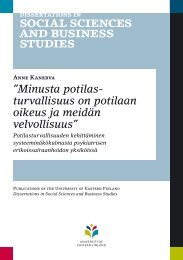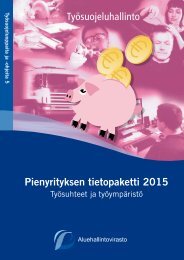urn_isbn_978-952-61-1770-6
urn_isbn_978-952-61-1770-6
urn_isbn_978-952-61-1770-6
- No tags were found...
You also want an ePaper? Increase the reach of your titles
YUMPU automatically turns print PDFs into web optimized ePapers that Google loves.
The opposite theory to judicial activism is judicial self-restraint. This is connectedto originalist theories which criticise extending methods of interpretation.There are two differentiated groups of originalist theories. The first emphasisesthat a legal provision must mean what it was taken to mean at the time of its enactment.The second emphasises that a legal provision must apply to whatevercases the drafters had originally intended it to apply. Originalism, in its variousforms, has been a very influential doctrine in American constitutional law. 166 Itis held by many constitutional theorists as well as judges and has always beenvery controversial. Among other things, it has become the favourite theory ofadvocates of judicial self-restraint. 167 The originalist point of view has also beenemphasised by the ECtHR’s judges. For example, in Golder, a dissenting opinioncalled for judicial restraint, contesting that it is unacceptable to read into the texta right which the Convention does not trouble to name, and at the most implies. 168A critical approach to the legitimacy debate regards talk of legitimacy as purenoise. 169 Since legitimacy is a wide concept, it is always necessary to specify whatone means by it. This is crystallised in the following comment: ‘“Legitimacy” isone of the most frequently used and misused concepts in political science.’ 170 Thisis inevitably true also in legal research.2.3 THE LEGITIMACY DEBATE TARGETED TOWARDS THEECtHRThe creation of the Convention was uncontroversial: after World War II an organisationto secure human rights in Europe was needed. The founding of theorganisation of the Council of Europe and its main instrument, the Convention,was justified and barely anyone questioned the need for its creation and existence.171 In this sense, no serious evaluation of the legitimacy of the European humanrights organisation and its institutions was required. Legitimacy questionsarose later and criticism has, on the one hand, focused mainly on the extensiveinterpretation of the Convention by the ECtHR; and, on the other hand, on delaysin processing cases and institutional concerns. 172 However, the conditions underwhich the Convention system was created in the 1950s and the world today, in the21st century, are hardly comparable.166For more on originalism and its counterpart, living constitutionalism, see Roosevelt 2006, at 47–59.167Scalia 1989; Lyons 1986; Letsas 2009, at 60–<strong>61</strong>.168Dissenting opinion of Sir Gerald Fitzmaurice in Golder v. The United Kingdom (1975).169Koskenniemi 2003, at 367.170Schmitter says: ‘“Legitimacy” is one of the most frequently used and misused concepts in politicalscience. It ranks up there with “power” in terms of how much it is needed, how difficult it is to defineand how impossible it is to measure.’ (Schmitter 2001).171Bates 2010; Spano 2014, at 1–3; McKaskle 2005, at 8–13. By contrast, the WTO dispute settlementsystem faced criticism at the time of its inception; see Kulovesi 2011, at 3.172Myjer 2012; O’Boyle 2011; Spano 2014, at 2–4.37




